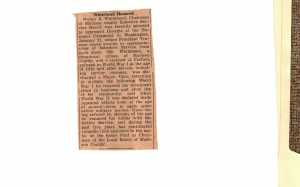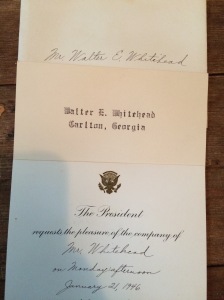Columbus Augustus Stevens
I have written about my second great-grandfather on my paternal side, Columbus Augustus “Gus” Stevens, before. However, I do not think I went through his biography, until today. I came across his death certificate and thought you should know about the life he lived for 84 years.
Gus was born on 26 June 1844 in Oglethorpe County, Georgia. His parents were Obadiah Stevens and Martha Patsy Watkins. Gus was born and raised in Oglethorpe County. His father was a Farmer in Oglethorpe. When you are trying to research a person in our distant past, we lean on records to help build the frame of the person. Oftentimes, researches only have the basic census data. I am lucky enough to have had my ancestors that were our family historians. These records can help sketch in the details of the character of that person. I have been fortunate that some records came from the family homes directly.
Here is the story about Gus: Plantar, Veteran, Believer, and Citizen.
Upbringing
Columbus Augustus Stevens was born in rural Georgia (Oglethorpe County) with his three brothers and his parents. Gus first appears on the 1850 Census. Gus was 6 years old; he lived with his parents, and his three brothers. His father was a farmer and had listed $3000 of real estate. His family was like others in rural Georgia. The family owned slaves. According to the 1850 Census, Obadiah had about 15 slaves.
By the 1860 Census, Gus was sixteen. He lived with his parents and his grandmother, Martha Stevens. His father, Obadiah, had $5000 in real estate and $20,500 in Personal Estate Value.
South Carolina seceded from the Union on 20 December 1860. The following year, several other states joined, including Gus’s State of Georgia. On 12 April 1861, the first shots at Fort Sumter indicated the beginning of the War Between the States. Gus was just 16 years old at the beginning of the War Between the States.
Civil War
Records indicate that Gus enlisted March 1862 at Lexington, Georgia into Echols Artillery. He was not quite eighteen years old. He remained a soldier until the surrender in April 1865. He went to war with his brother William and his cousin, John Cylvanus Gibson Stevens (JCG). In fact, if you look at this regiments roster, you would see many familial names including Whitehead, Mathews, Faust, etc.
Martha Whitehead (Gus’s granddaughter) wrote short episodes of certain things she remembered or had heard. We are fortunate enough that she shared them with her family. She went to live with her Grandfather, Gus, when her mother became bedridden due to a serious case of rheumatoid arthritis. [Below is an excerpt from her stories. While this is a true story, it also reflects the time-period and is not politically correct by today standards.]
An Afro-American looks after a confederate soldier by Martha Whitehead Moore:
“As I said, Grandpa was just 18 when he enlisted. Obadiah thought he and Cousin John Stevens (JCG) needed someone to go along with them to look after them. So one of Cuz John’s freed Afros went with the two whites to SC. He was Ab (short for Abner) Stevens and was an excellent cook. He also did the laundry for Grandpa and Cuz. John. Most important of all, he was a “good chicken thief”. He made food available, even for the Yanks who were “prisoners of war.”
History tells us that the life of a Confederate Soldier was challenging at best. Aside from the war itself, many Confederate soldiers were constantly hungry and sick. Troops went months without pay. Therefore, the fact that he came from a wealthy family meant he was able to get food and supplies.
Gus’s brother William Walter, died during the Civil War. It is unclear if he was a casualty of a weapon or a disease. Assigned to the Tiller’s Company, Georgia Light Artillery (Echols Light Artillery) like his brother and cousins.
According to the war records, Gus was paroled (surrender) at Greensboro, North Carolina on 28 April 1865. According to North Carolina History, the troops assembled at Greensboro to disarm themselves and return home (Kickler, 2005).

Statement of Service
I can only imagine the experiences that Gus had to endure during the War Between the States. However, to have your older brother killed in battle and then to surrender to the Union must have unnerved a young man.
After the War
After the War, Gus returned home to Oglethorpe County. On 4 July 1867, Gus signed the Qualified Voters and Reconstruction Oath Book. This indicates that he is living in Election District 236 of Oglethorpe County and has signed his allegiance back to the United States of America. I can only imagine what these men thought about signing this document after losing this War along with the bloodshed of their brethren.
According to the Ancestry website:
“The Reconstruction Acts of 1867 required Southern states to ratify the 14th Amendment, draft new state constitutions, and register voters, both black and white. In order to vote, men had to swear an oath of allegiance to the United States, and some were disqualified for their participation in Confederate government posts. This database contains books recording those oaths of allegiance and returns listing qualified voters registered in Georgia in 1867. It includes both black and white citizens (Ancestry).

Oath of Allegiance
Gus married Martha Jane Witcher four years after the war on 29 April 1869. They set up house in Oglethorpe County within his parents’ home. He was 24 years old. Gus would work with his father on the land as a plantar and farmer.
The following year, 1870, the United States held its Decennial Census. The census indicated that Gus and his wife had a baby and the family of three are living with his parents. Their first-born child Ambrose Pope was a listed as one month old.
In the 1880 Census, Gus and his growing family are still living with his parents. According to the census, their children Ambrose, Luna, Asa, Cynnie and Pellie, are all under ten years old.
The infamous 1890 US Census was burned, so we do not have that information. Nevertheless, we know that Gus’s father died in 1891.
According to the 1900 Census, Gus is Head of Household. Gus lives with his wife, Martha, and their son Asa, and his wife Lester. Asa is now helping to run the farm. Gus’s daughters Cynnie, Pellie, Fannie and Martha Obie reside in the home. His youngest son, Joe Augustus, 11 years old is living at home as well.
On 19 May 1909, Gus’s wife Martha Jane dies. They had been married for more than forty years.
In the 1910 Census, Gus was Head of House, his daughters Cynnie and Pellie still live with him. Martha Ann Whitehead is listed as a “Stevens” on this census. However, we know the true family history of how little Martha went to live there because her mother was bedridden. Martha’s mom, Luna May, had her two maiden sisters help care for little Martha.

Martha Ann Whitehead with her grandfather Gus Stevens
By the 1920 Census, Gus is living with his two maiden daughters, Cynnie and Pellie, his grandson Joseph A Stevens (31 years old) and his granddaughter Martha Ann Whitehead (15 years old).

L-R: Margaret Whitehead, Walter Whitehead, Mae (in arms) Cynnie or Pellie Stevens (in hat), Gus Stevens, Cynnie or Pellie, Fred Whitehead
Civic Life
After establishing himself as a plantar and merchant, Gus set his sights on public service. According to the Oglethorpe Echo, Gus served one term as a Representative in the House of Representatives (1892-93). He additionally served one term in the Georgia Senate (1902-1904) for the 30th District. He was a member of the Masonic Order. He was also on the County Board of Education for a few years (Oglethorpe Echo, 1929).
Merchant
Gus, his brother, John Reese and his first cousin, JCG Stevens along with Robert Huff, started a general store in 1885 in the Village of Sandy Cross, Stevens Huff and Company. Additional stores and properties were added later. In fact, at one point they had two stores and 5 cotton gins covering Madison and Oglethorpe County. The company survived two World Wars and a Great Depression but ultimately dissolved voluntarily in 1963 (Stevens, 1973). [I did a general post about it here: Mercantile Business]

Circa 1903
Believer
Gus loved God and Country as we have seen. Most community activities centered on the church in these days. According to the obituary written in the Oglethorpe Echo, Gus joined Clouds Creek Baptist Church around the same time he married Martha, 1869. He became an ordained deacon on 5 October 1877. On 9 September 1906, a new Church was chartered in Oglethorpe County. The church, Sandy Cross Baptist Church was established from members of both Clouds Creek and Bethany Baptist Church. My second great grandfather was one of the founding members. He was one of the Deacons. I found an article written about the church and it lists several of my ancestors. In death, he bequeathed a house and property (4 acres) to Sandy Cross Baptist Church.

Article about Sandy Cross Baptist Church written by family friend and Minister Faust
His Death Certificate indicates that he died of hypostatic pneumonia. However, he had incurred a hip fracture just 5 days earlier when he fell. The local newspaper, the Oglethorpe Echo, published a snippet this nice tribute following his death.
In May 2015, I took my sister and cousin Susan to Georgia for a genealogy trip. Aunt Leah met us there and we were fortunate enough to visit Miss Kitty. She still resides in the Steven’s family home.
While preparing for this piece, I wrote to my cousins for their input. Cousin Lynn, daughter of Miss Kitty, shared this story:
The Stevenses killed a “hawg” on the first frozen day of the year, everyone who participated got a share of the meat. There was a GIANT cement pit, like we would see now in an oil-change shop, where they did some part of the process. And there were GIANT cast-iron pots, as large as a bathtub but semi-spherical, where (I think) they boiled water to help scrape the wiry hairs off the skin.
She also shared this about the main house: I believe the Oglethorpe County Tax Assessor shows that the house was built in 1901. But there are tales about the kitchen being a separate building during the Civil War, and it was eventually jacked onto logs and ROLLED up to the main house. This certainly ties into the differing floor levels between the dining room, the butler’s pantry, and the kitchen itself!

There is so much more to say about Gus, but it will have to wait for another day. If you have memories, please share them here!
Until later, I will be exploring backwards.
Source:
Ancestry.com. Georgia, Returns of Qualified Voters and Reconstruction Oath Books, 1867-1869 [database on-line]. Provo, UT, USA: Ancestry.com Operations, Inc., 2012. Original data: Georgia, Office of the Governor. Returns of qualified voters under the Reconstruction Act, 1867. Georgia State Archives, Morrow, Georgia.
Compiled Service Records of Conferate Soldiers who served in Organizations from the State of Georga., NARA, Publication Number M266.
NorthCarolinahistory.org: An Online Encyclopedia, “Lunsford Lane” (by Troy Kickler), http://northcarolina.org (accessed 5/31/2019).
Oglethorpe Echo, March 8, 1929. Article about CA Stevens Death
Stevens, Claude G., 1973. The Stevens Family, John Stevens Line, Commercial Printing Company, Inc. Toccoa, Georgia.








